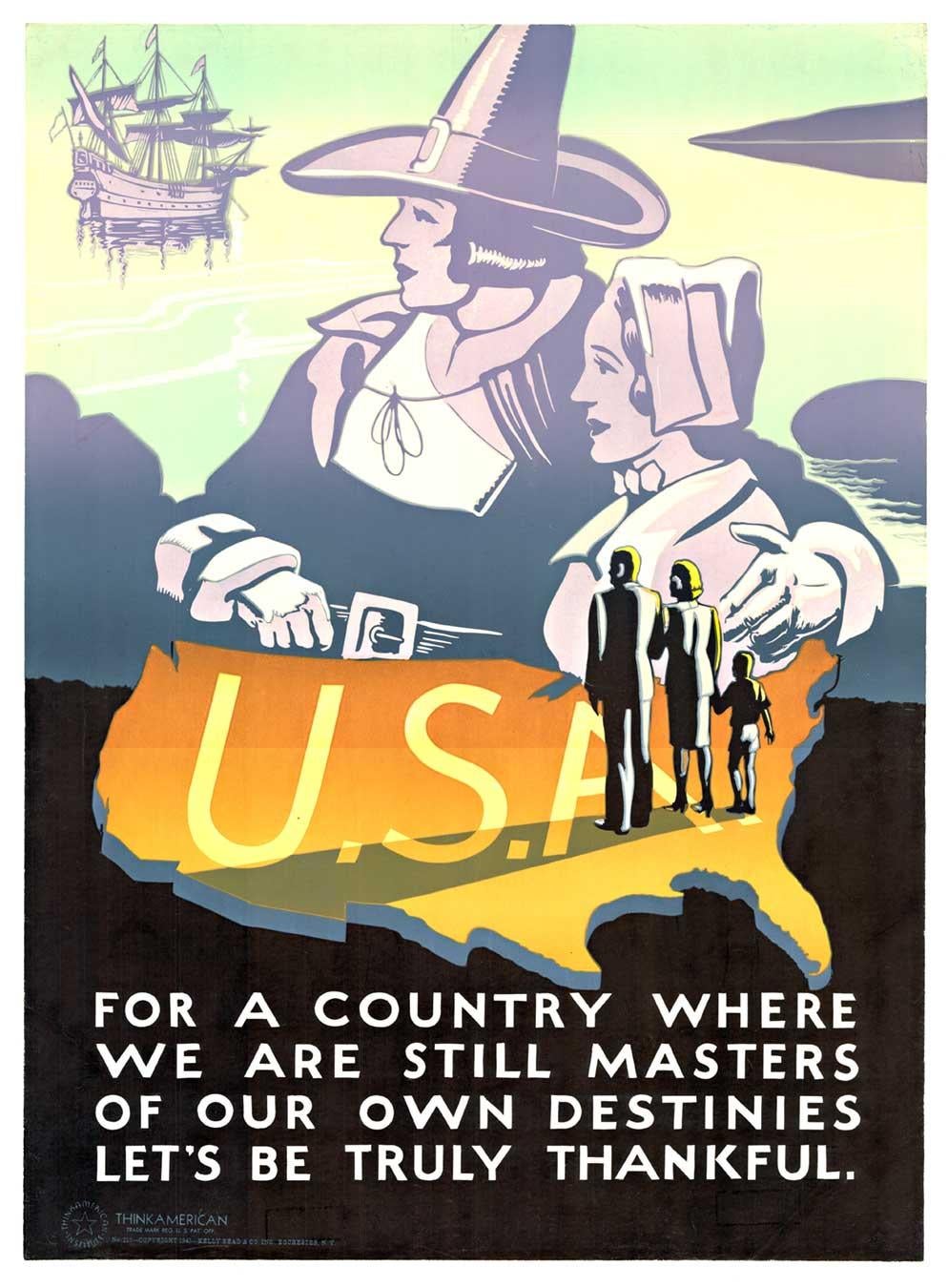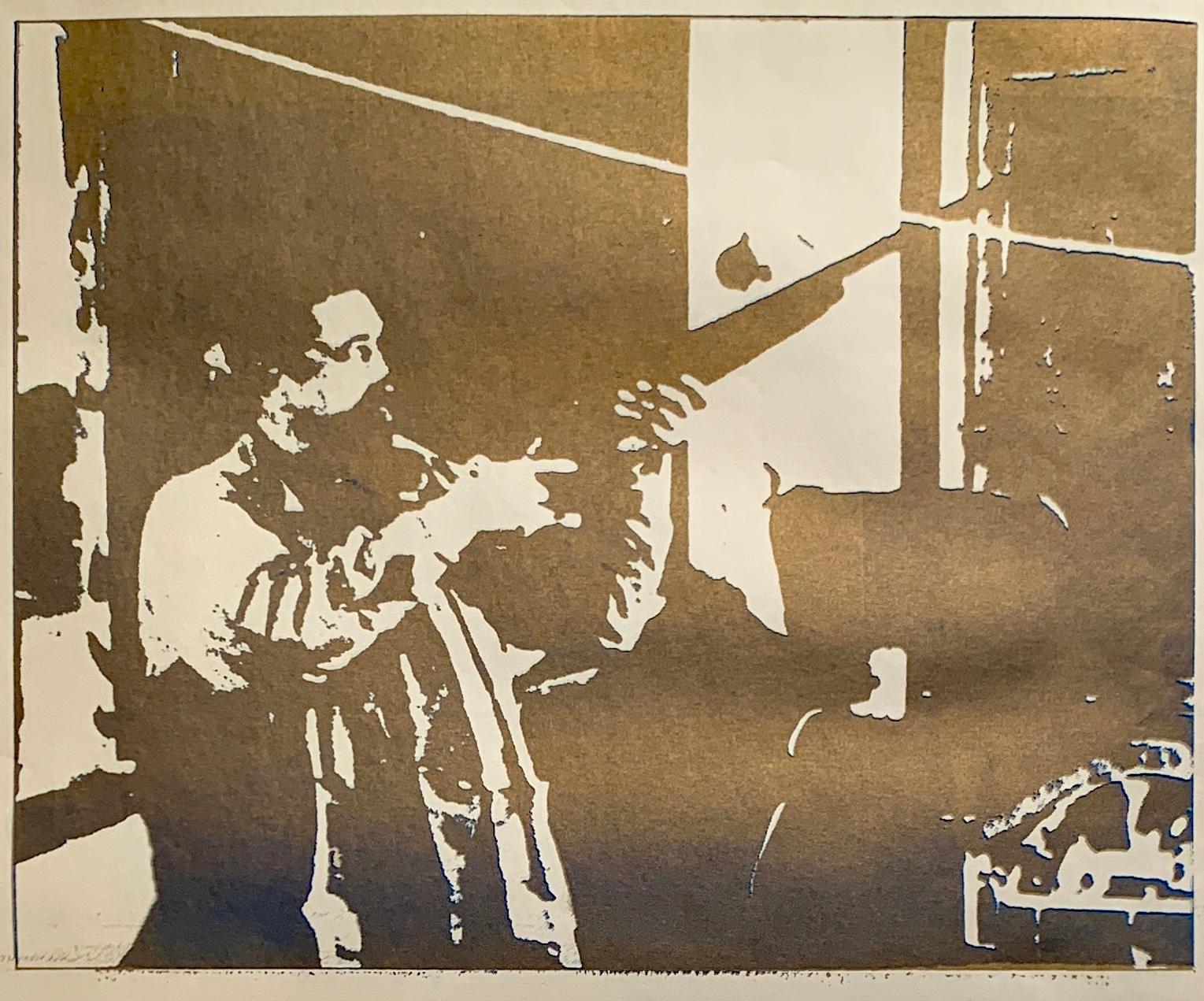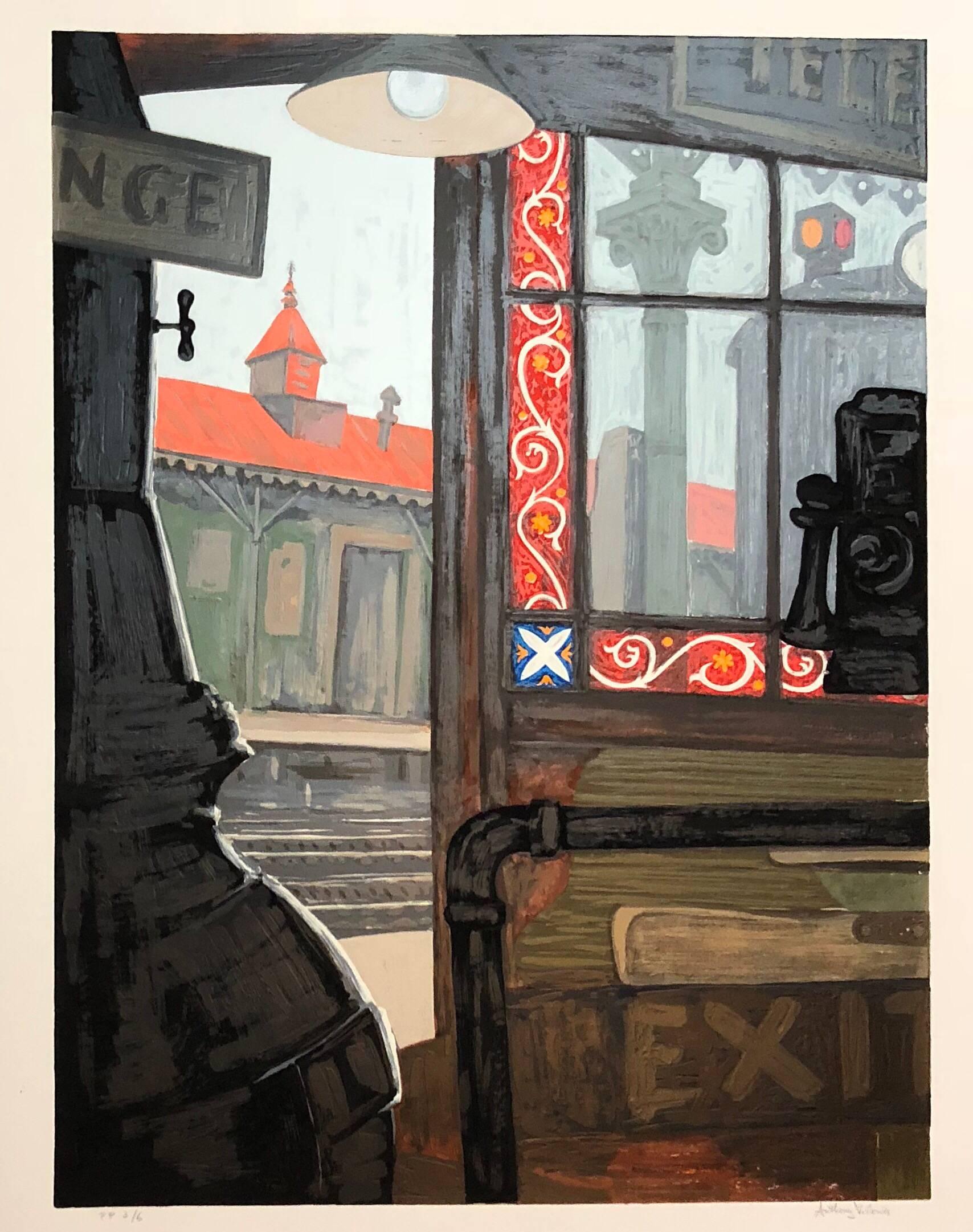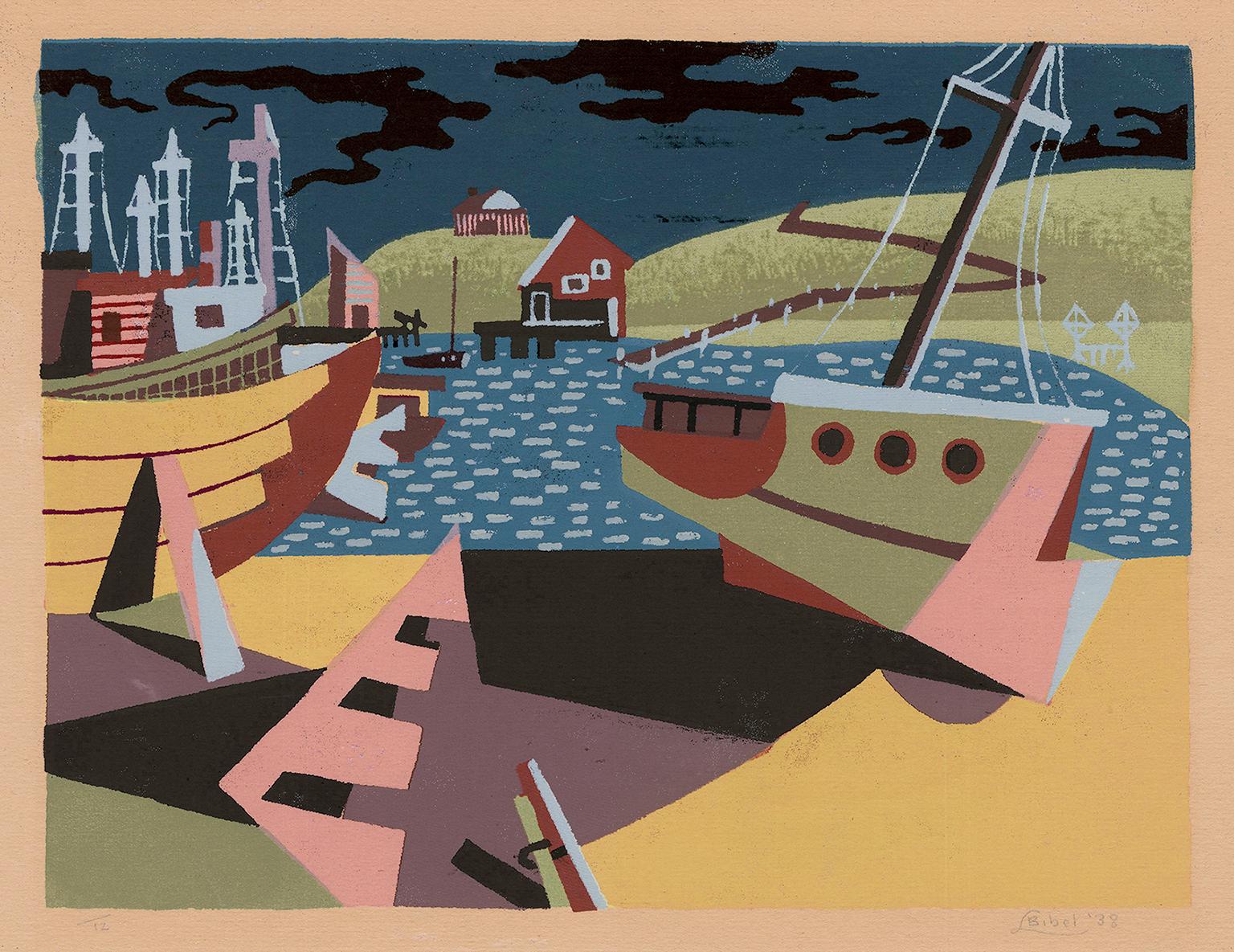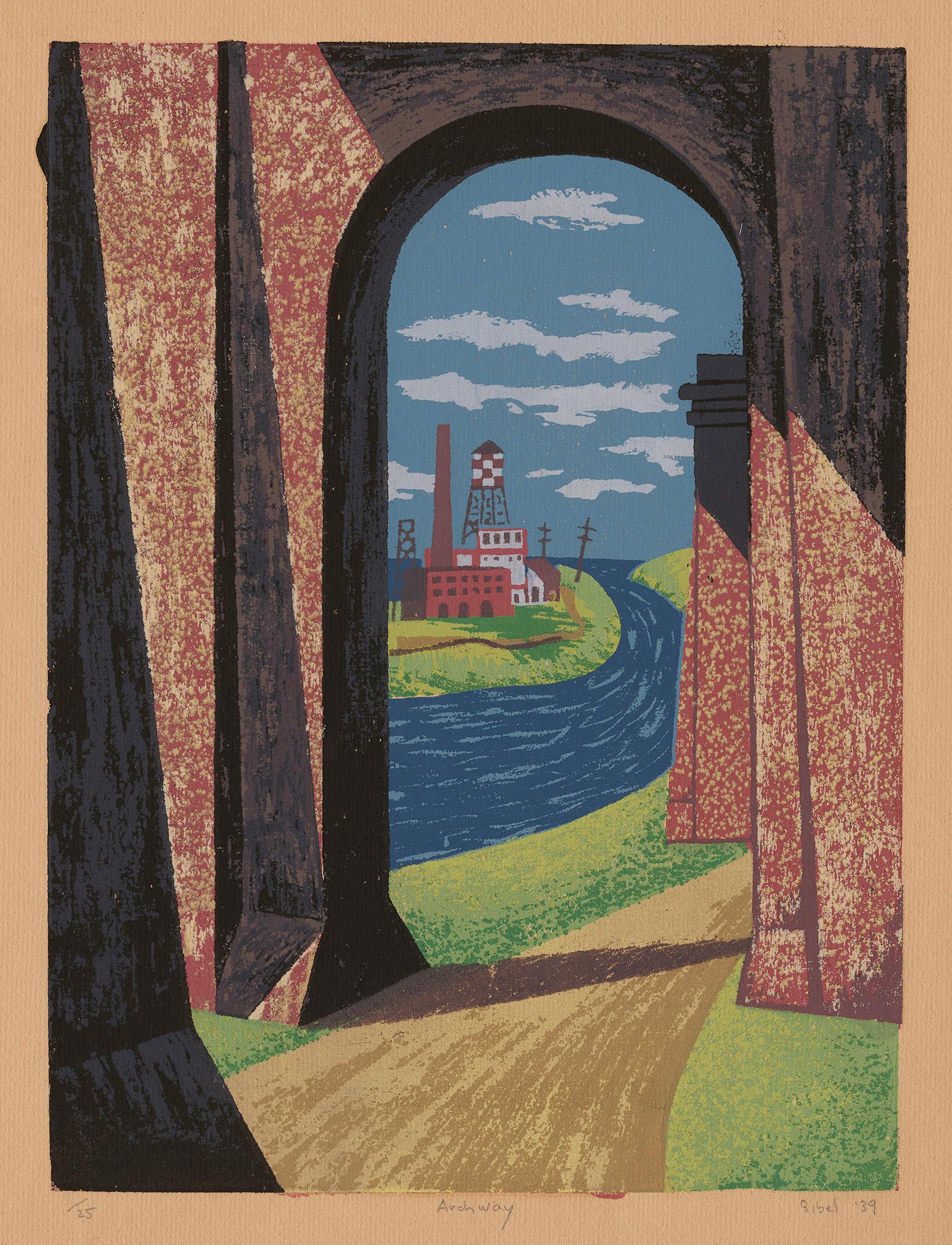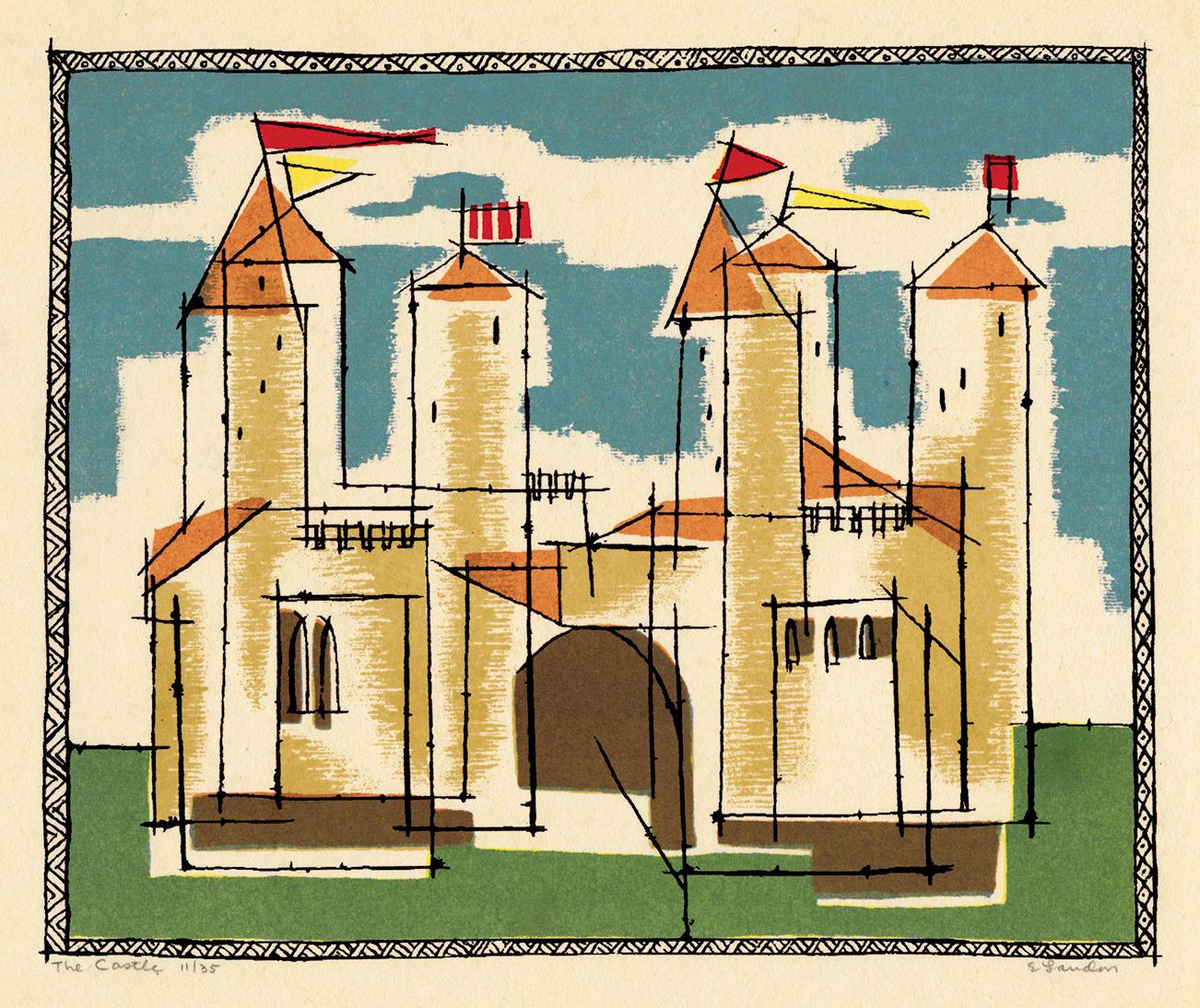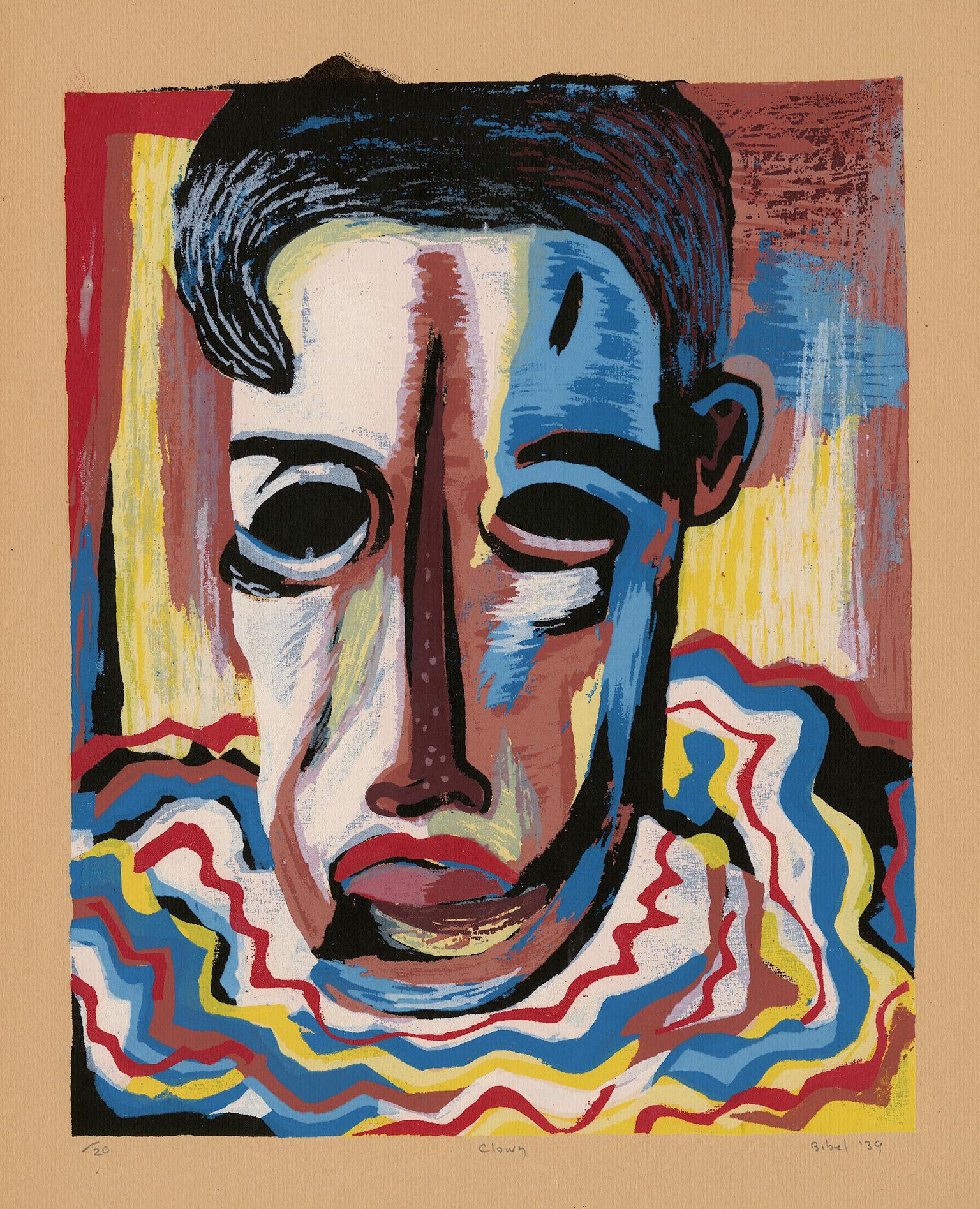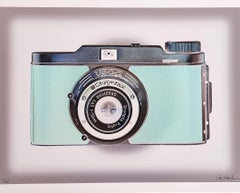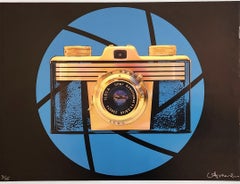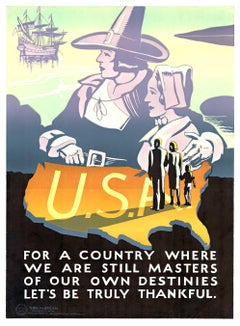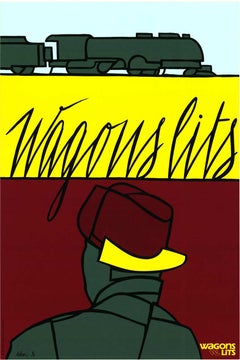
Number Suite - Four
View Similar Items
Robert IndianaNumber Suite - Four1968
1968
About the Item
- Creator:Robert Indiana (1928 - 2018, American)
- Creation Year:1968
- Dimensions:Height: 10 in (25.4 cm)Width: 8.25 in (20.96 cm)
- Medium:
- Movement & Style:
- Period:
- Condition:
- Gallery Location:Kansas City, MO
- Reference Number:Seller: RIN_1902_041stDibs: LU60834033752
Robert Indiana
Robert Indiana's work evolved into hard-edged graphic images of words, logos and typographic forms, earning him a reputation as one of the country's leading contemporary artists.
Indiana is known for using public signs and symbols with altered lettering to make stark and challenging visual statements. In his prints, paintings and constructions, he gave new meaning to basic words like Eat, Die and Love. Using them in bold block letters in vivid colors, he enticed his viewers to look at the commonplace from a new perspective. One indication of his success was the appearance of his immensely popular multi-colored Love on a United States postage stamp in 1973.
Find a collection of original Robert Indiana art today on 1stDibs.
- Fruit Tree (Japanese-American, Sculptor, Print Maker, Cultural Identity, Iconic)By Akio TakamoriLocated in Kansas City, MOAkio Takamori Fruit Tree, 1993 Medium: 4 Color Lithograph Edition: 30 Paper: Rives BFK, White Paper Size: 33.5″ x 15″ Image Size: 29.5″ x 11″ Signed, dated, numbered and inscribed by...Category
1990s American Modern Figurative Prints
MaterialsLithograph, Archival Paper
- Vega ChrontaxLocated in Kansas City, MOLouise Marler Vega Chrontax Archival Pigment Print on premium luster 2022 Size: 16x20in Edition: 25 Signed and numbered by hand Stamped COA provided Ref.: 924802-1416 Louise Marler’s photo-based Mixed Media art, is iconic visual vocabulary. Au-thentic style has led to exhibits, art collections and events which integrate his-tory, education, and entertainment. Raised in a family that collected, sold and repaired typewriters. These and other analog, vintage machines are part of her personal history and led naturally to becoming part of the subject matter of her visual expression. Louise Marleris inspired by Americana and also influenced by pop art and technology. “I developed my unique art style in a Santa Monica Airport (former mechanic) hanger turned art studio. I currently live and work in St. Louis where antique row meets the most progressive art culture, as well as Joshua Tree, California, where I created the first Type Inn.” Louise Marler’s work is featured in the documentary film, “The Typewriter in the 21st Century,” and TV shows including “Two and a Half Men,” “Curb Your Enthusiasm,” “The Mentalist,” “Criminal Minds,” “Jane the Virgin,” “Dear White People,” “Lucifer,” “Arrested Development,” “Love Victor, and “A Black Lady Sketch.” film photography, film camera, film is not dead, film community, old camera...Category
2010s American Modern Figurative Prints
MaterialsArchival Paper, Archival Pigment, Archival Ink
$888 Sale Price44% Off - KoniRapid-SLocated in Kansas City, MOLouise Marler KoniRapid-S Archival Pigment Print on premium luster 2022 Size: 16x20in Edition: 25 Signed and numbered by hand Stamped COA provided Ref.: 924802-1417 Louise Marler’s photo-based Mixed Media art, is iconic visual vocabulary. Au-thentic style has led to exhibits, art collections and events which integrate his-tory, education, and entertainment. Raised in a family that collected, sold and repaired typewriters. These and other analog, vintage machines are part of her personal history and led naturally to becoming part of the subject matter of her visual expression. Louise Marleris inspired by Americana and also influenced by pop art and technology. “I developed my unique art style in a Santa Monica Airport (former mechanic) hanger turned art studio. I currently live and work in St. Louis where antique row meets the most progressive art culture, as well as Joshua Tree, California, where I created the first Type Inn.” Louise Marler’s work is featured in the documentary film, “The Typewriter in the 21st Century,” and TV shows including “Two and a Half Men,” “Curb Your Enthusiasm,” “The Mentalist,” “Criminal Minds,” “Jane the Virgin,” “Dear White People,” “Lucifer,” “Arrested Development,” “Love Victor, and “A Black Lady Sketch.” film photography, film camera, film is not dead, film community, old camera...Category
2010s American Modern Figurative Prints
MaterialsArchival Ink, Archival Paper, Archival Pigment
$888 Sale Price44% Off - Silver Sprinters - Olympia 1974By John Paul JonesLocated in Kansas City, MOSilver Sprinters - Olympia 1974 Serigraph Edition: 200 Signed by the Artist Size: 100 x 64 cm (25 x 40 inches) COA provided John Paul Jones (November 18, 1924 – 1999) was an America...Category
1970s Modern Figurative Prints
MaterialsScreen
$488 Sale Price30% Off - SharakuLocated in Kansas City, MOGaston Petit Sharaku Color Lithograph and Silkscreen Year: 1980 Size: 27.6X17.6in Edition: 85 Signed and dated by hand COA provided Ref.: 924802-1200 Fat...Category
1980s Modern Prints and Multiples
MaterialsLithograph, Screen
$144 Sale Price51% Off - (Partial) Portfolio containing 3 (three) lithographs and etchingsBy GraficaLocated in Kansas City, MOGrafica '68 (Partial) Portfolio containing 3 (three) lithographs and etchings Originally issued with 10 Lithographs, Silk Screens and Etchings, of which 7 (seven) are missing Year: 1968 Edition: 100 Size: 17.6 x 23.6 in. or 23.6 x 17.6 in. Publisher: Il Torcoliere, Rome - Italy Signatures: Sheets signed and numbered by hand Comes with folio box and individual artists' presentation sheets. --------------------------------- Artists works included: RENZO VESPIGNANI "Report on the artist" Year: 1968 Medium: Lithograph in two colors Edition: 100 Size: 17.6 x 23.6 in. Publisher: Il Torcoliere, Rome - Italy Signed and numbered Ref: RVE_1909_01 LUCIANO DE VITA "Le cavalier inconnu" Year: 1968 Medium: Etching Edition: 100 Size: 23.6 x 17.6 in. Publisher: Il Torcoliere, Rome - Italy Signed and numbered Ref: LDV_1909_01 PIERO GUCCIONE "Images" Year: 1968 Medium: Lithograph in four colors Edition: 100 Size: 23.6 x 17.6 in. Publisher: Il Torcoliere, Rome - Italy Signed and numbered Ref: PGU_1909_01 ======================= Renzo Vespignani was an Italian painter, printmaker and illustrator. Vespignani illustrated the works of Boccaccio, Kafka and T. S. Eliot, among others. In 1956, he co-founded the magazine Citta Aperta and in 1963, co-founded the group II Pro e II Contro for neorealism in figure art. ---------------- Luciano De Vita ( Ancona , 1929 - 1992 ) was an Italian painter , engraver , set designer and lecturer . Born in Ancona, De vita arrived in Bologna in the first post-war period, after having actively participated in the Second World War and having suffered the dramatic consequences. He attended the Academy of Fine Arts and was a pupil of Giorgio Morandi. From 1962 he taught in Milan at the Brera Academy , while in 1975 he returned to Bologna where he obtained the same chair of engraving that had been Morandi's from 1930 to 1956 . De Vita also actively dedicated himself to the theater , overseeing sets and costumes for shows that were also staged at La Scala in Milan. An example is the Turandot curated by Raoul Grassilli. ---------------- Emilio Vedova (9 August 1919 – 25 October 2006) was a modern Italian painter...Category
1960s Modern Figurative Prints
MaterialsEtching, Lithograph, Screen
- Original "Think American" USA World War II vintage posterLocated in Spokane, WAOriginal poster: For a Country Where We Are Still Masters of Our Own Destinies, Let's Be Truly Thankful. Silk-screened patriotism. This is a poster meant to appeal to the American family. Soft, rich colors and a patriotic vision... This poster has been archivally mounted on linen and is in fine condition condition. Touched up pin-holes in the corners. A- condition. The Original Think American, USA World War 2 Poster is a captivating piece of history and art. This vintage poster showcases a unique design that captures the era's essence. It features a pilgrim couple gazing out to sea towards their three-master schooner, representing America's pioneering and adventurous spirit. The outline of the United States is a powerful symbol of national pride and strength. The large text along the bottom of the poster delivers a thought-provoking message, reminding viewers to be grateful for the country where they can shape their own destinies. Created and printed by Think America, a renowned brand, this poster is a true collector's item that celebrates American history and values. The ghosted image of early Pilgrims seems to reach out to the American family who are standing on an outline of the United States. The old sailing...Category
1940s American Modern Figurative Prints
MaterialsScreen
- Original "Wagon Lits" pop art style serigraph travel by train posterBy Valerio AdamiLocated in Spokane, WAOriginal “Wagon Lits” serigraph poster by the artist Valerio Adami. It was printed in France by GrafiCaza (Michel Caza), one of the finest serigraph companies on woven paper—in exce...Category
1990s American Modern Figurative Prints
MaterialsScreen
- "Gold and Blue Gun" 1970s Original Portrait SilkscreenLocated in Arp, TXArtist unknown "Gold and Blue Gun" c. 1970s Silkscreen on paper Image size 21.25"x17" paper size 26"x40" unframed $350 Unsigned *Listed price reflects custom framing selected by sell...Category
1970s American Modern Figurative Prints
MaterialsPaper, Screen
- "The Capture, " Jacob Lawrence, Harlem Renaissance, Black Art, Haitian SeriesBy Jacob LawrenceLocated in New York, NYJacob Lawrence (1917 - 2000) The Capture of Marmelade (from The Life of Toussaint L'Ouverture series), 1987 Color screenprint on Bainbridge Two Ply Rag paper Sheet 32 1/8 x 22 1/16 inches Sight 29 3/4 x 19 1/4 inches A/P 1/30, aside from the edition of 120 Signed, titled, dated, inscribed "A/P" and numbered 1/30 in pencil, lower margin. Literature: Nesbett L87-2. A social realist, Lawrence documented the African American experience in several series devoted to Toussaint L’Ouverture, Frederick Douglass, Harriet Tubman, life in Harlem, and the civil rights movement of the 1960s. He was one of the first nationally recognized African American artists. “If at times my productions do not express the conventionally beautiful, there is always an effort to express the universal beauty of man’s continuous struggle to lift his social position and to add dimension to his spiritual being.” — Jacob Lawrence quoted in Ellen Harkins Wheat, Jacob Lawrence: The Frederick Douglass and Harriet Tubman Series of 1938 – 40. The most widely acclaimed African American artist of this century, and one of only several whose works are included in standard survey books on American art, Jacob Lawrence has enjoyed a successful career for more than fifty years. Lawrence’s paintings portray the lives and struggles of African Americans, and have found wide audiences due to their abstract, colorful style and universality of subject matter. By the time he was thirty years old, Lawrence had been labeled as the “foremost Negro artist,” and since that time his career has been a series of extraordinary accomplishments. Moreover, Lawrence is one of the few painters of his generation who grew up in a black community, was taught primarily by black artists, and was influenced by black people. Lawrence was born on September 7, 1917,* in Atlantic City, New Jersey. He was the eldest child of Jacob and Rosa Lee Lawrence. The senior Lawrence worked as a railroad cook and in 1919 moved his family to Easton, Pennsylvania, where he sought work as a coal miner. Lawrence’s parents separated when he was seven, and in 1924 his mother moved her children first to Philadelphia and then to Harlem when Jacob was twelve years old. He enrolled in Public School 89 located at 135th Street and Lenox Avenue, and at the Utopia Children’s Center, a settlement house that provided an after school program in arts and crafts for Harlem children. The center was operated at that time by painter Charles Alston who immediately recognized young Lawrence’s talents. Shortly after he began attending classes at Utopia Children’s Center, Lawrence developed an interest in drawing simple geometric patterns and making diorama type paintings from corrugated cardboard boxes. Following his graduation from P.S. 89, Lawrence enrolled in Commerce High School on West 65th Street and painted intermittently on his own. As the Depression became more acute, Lawrence’s mother lost her job and the family had to go on welfare. Lawrence dropped out of high school before his junior year to find odd jobs to help support his family. He enrolled in the Civilian Conservation Corps, a New Deal jobs program, and was sent to upstate New York. There he planted trees, drained swamps, and built dams. When Lawrence returned to Harlem he became associated with the Harlem Community Art Center directed by sculptor Augusta Savage, and began painting his earliest Harlem scenes. Lawrence enjoyed playing pool at the Harlem Y.M.C.A., where he met “Professor” Seifert, a black, self styled lecturer and historian who had collected a large library of African and African American literature. Seifert encouraged Lawrence to visit the Schomburg Library in Harlem to read everything he could about African and African American culture. He also invited Lawrence to use his personal library, and to visit the Museum of Modern Art’s exhibition of African art in 1935. As the Depression continued, circumstances remained financially difficult for Lawrence and his family. Through the persistence of Augusta Savage, Lawrence was assigned to an easel project with the W.P.A., and still under the influence of Seifert, Lawrence became interested in the life of Toussaint L’Ouverture, the black revolutionary and founder of the Republic of Haiti. Lawrence felt that a single painting would not depict L’Ouverture’s numerous achievements, and decided to produce a series of paintings on the general’s life. Lawrence is known primarily for his series of panels on the lives of important African Americans in history and scenes of African American life. His series of paintings include: The Life of Toussaint L’Ouverture, 1937, (forty one panels), The Life of Frederick Douglass, 1938, (forty panels), The Life of Harriet Tubman, 1939, (thirty one panels), The Migration of the Negro,1940 – 41, (sixty panels), The Life of John Brown, 1941, (twenty two panels), Harlem, 1942, (thirty panels), War, 1946 47, (fourteen panels), The South, 1947, (ten panels), Hospital, 1949 – 50, (eleven panels), Struggle: History of the American People, 1953 – 55, (thirty panels completed, sixty projected). Lawrence’s best known series is The Migration of the Negro, executed in 1940 and 1941. The panels portray the migration of over a million African Americans from the South to industrial cities in the North between 1910 and 1940. These panels, as well as others by Lawrence, are linked together by descriptive phrases, color, and design. In November 1941 Lawrence’s Migration series was exhibited at the prestigious Downtown Gallery in New York. This show received wide acclaim, and at the age of twenty four Lawrence became the first African American artist to be represented by a downtown “mainstream” gallery. During the same month Fortune magazine published a lengthy article about Lawrence, and illustrated twenty six of the series’ sixty panels. In 1943 the Downtown Gallery exhibited Lawrence’s Harlem series, which was lauded by some critics as being even more successful than the Migration panels. In 1937 Lawrence obtained a scholarship to the American Artists School in New York. At about the same time, he was also the recipient of a Rosenwald Grant for three consecutive years. In 1943 Lawrence joined the U.S. Coast Guard and was assigned to troop ships that sailed to Italy and India. After his discharge in 1945, Lawrence returned to painting the history of African American people. In the summer of 1947 Lawrence taught at the innovative Black Mountain College in North Carolina at the invitation of painter Josef Albers. During the late 1940s Lawrence was the most celebrated African American painter in America. Young, gifted, and personable, Lawrence presented the image of the black artist who had truly “arrived”. Lawrence was, however, somewhat overwhelmed by his own success, and deeply concerned that some of his equally talented black artist friends had not achieved a similar success. As a consequence, Lawrence became deeply depressed, and in July 1949 voluntarily entered Hillside Hospital in Queens, New York, to receive treatment. He completed the Hospital series while at Hillside. Following his discharge from the hospital in 1950, Lawrence resumed painting with renewed enthusiasm. In 1960 he was honored with a retrospective exhibition and monograph prepared by The American Federation of Arts. He also traveled to Africa twice during the 1960s and lived primarily in Nigeria. Lawrence taught for a number of years at the Art Students League in New York, and over the years has also served on the faculties of Brandeis University, the New School for Social Research, California State College at Hayward, the Pratt Institute, and the University of Washington, Seattle, where he is currently Professor Emeritus of Art. In 1974 the Whitney Museum of American Art in New York held a major retrospective of Lawrence’s work that toured nationally, and in December 1983 Lawrence was elected to the American Academy of Arts and Letters. The most recent retrospective of Lawrence’s paintings was organized by the Metropolitan Museum of Art in 2020, and was accompanied by a major catalogue. Lawrence met his wife Gwendolyn Knight...Category
1970s American Modern Figurative Prints
MaterialsScreen, Paper
$10,000 Sale Price20% Off - Modernist Figurative Pop Art Etching and Aquatint "the Artist" Michael MazurBy Michael MazurLocated in Surfside, FLMichael Mazur "The Artist" Hand signed and editioned from the edition of 50 1967 Michael Burton Mazur (1935-August 18, 2009) was an American artist who was described by William Grimes of The New York Times as "a restlessly inventive printmaker, painter, and sculptor." Born and raised in New York City, Mazur attended the Horace Mann School. He received a bachelor's degree from Amherst College in 1958, then studied art at Yale. Mazur first gained notice for his series of lithographs and etchings of inmates in a mental asylum, which resulted in two publications, "Closed Ward" and "Locked Ward." Over the years, he worked in printmaking and painting. His series of large-scale prints for Dante's Inferno won critical acclaim, and were the subject of a traveling exhibition organized by the University of Iowa in 1994. Later he concentrated on creating large, lyrical paintings which make use of his free, gestural brushwork and a varied palette. Some of these paintings were seen in an exhibition of 2002 at Boston University, "Looking East: Brice Marden, Michael Mazur, and Pat Steir." (See also Susan Danly, "Branching: The Art of Michael Mazur," 1997). The Museum of Fine Arts, Boston, has acquired a definMichael Mazur received a B.A. from Amherst College in 1957, studying in his senior year at the Accademia di Belle Arti in Florence, Italy. He went on to earn both a B.F.A. and an M.F.A. from the Yale School of Art and Architecture in 1961. Mazur's first teaching job was at the Rhode Island School of Design from 1961 to 1964. He was awarded a Guggenheim Foundation fellowship for 1964–65. From 1965 to 1976, he taught at Brandeis University, and from 1976 to 1978 at Harvard University. As an artist, teacher, and writer, Mazur has been active in reviving the monotype process. He contributed an essay to the pioneering exhibition catalogue The Painterly Print, published by the Metropolitan Museum of Art in 1980. Mazur recently chaired the New Provincetown Print...Category
Early 2000s American Modern Abstract Prints
MaterialsLithograph, Screen
- Modernist Silkscreen Screenprint 'El Station, Interior' NYC Subway, WPA ArtistBy Anthony VelonisLocated in Surfside, FLscreenprint printed in color ink on wove paper. New York City subway station interior. Anthony Velonis (1911 – 1997) was an American painter and designer born in New York City who helped introduce the public to silkscreen printing in the early 20th century. While employed under the federal Works Progress Administration, WPA during the Great Depression, Velonis brought the use of silkscreen printing as a fine art form, referred to as the "serigraph," into the mainstream. By his own request, he was not publicly credited for coining the term. He experimented and mastered techniques to print on a wide variety of materials, such as glass, plastics, and metal, thereby expanding the field. In the mid to late 20th century, the silkscreen technique became popular among other artists such as Robert Rauschenberg and Andy Warhol. Velonis was born into a relatively poor background of a Greek immigrant family and grew up in the tenements of New York City. Early on, he took creative inspiration from figures in his life such as his grandfather, an immigrant from the mountains in Greece, who was "an ecclesiastical painter, on Byzantine style." Velonis attended James Monroe High School in The Bronx, where he took on minor artistic roles such as the illustration of his high school yearbook. He eventually received a scholarship to the NYU College of Fine Arts, into which he was both surprised and ecstatic to have been admitted. Around this time he took to painting, watercolor, and sculpture, as well as various other art forms, hoping to find a niche that fit. He attended NYU until 1929, when the Great Depression started in the United States after the stock market crash. Around the year 1932, Velonis became interested in silk screen, together with fellow artist Fritz Brosius, and decided to investigate the practice. Working in his brother's sign shop, Velonis was able to master the silkscreen process. He reminisced in an interview three decades later that doing so was "plenty of fun," and that a lot of technology can be discovered through hard work, more so if it is worked on "little by little." Velonis was hired by Mayor LaGuardia in 1934 to promote the work of New York's city government via posters publicizing city projects. One such project required him to go on a commercial fishing trip to locations including New Bedford and Nantucket for a fortnight, where he primarily took photographs and notes, and made sketches. Afterward, for a period of roughly six months, he was occupied with creating paintings from these records. During this trip, Velonis developed true respect and affinity for the fishermen with whom he traveled, "the relatively uneducated person," in his words. Following this, Velonis began work with the Public Works of Art Project (PWAP), an offshoot of the Civil Works Administration (CWA), where he was assigned to serve the different city departments of New York. After the formation of the federal Works Progress Administration, which hired artists and sponsored projects in the arts, he also worked in theater. Velonis began working for the federal WPA in 1935. He kept this position until 1936 or 1938, at which point he began working in the graphic art division of the Federal Art Project, which he ultimately led. Under various elements of the WPA program, many young artists, writers and actors gained employment that helped them survive during the Depression, as well as contributing works that created an artistic legacy for the country. When interviewed in December 1994 by the Library of Congress about his time in the WPA, Velonis reflected that he had greatly enjoyed that period, saying that he liked the "excitement" and "meeting all the other artists with different points of view." He also said in a later interview that "the contact and the dialogue with all those artists and the work that took place was just invaluable." Among the young artists he hired was Edmond Casarella, who later developed an innovative technique using layered cardboard for woodcuts. Velonis introduced silkscreen printing to the Poster Division of the WPA. As he recalled in a 1965 interview: "I suggested that the Poster division would be a lot more productive and useful if they had an auxiliary screen printing project that worked along with them. And apparently this was very favorably received..." As a member of the Federal Art Project, a subdivision of the WPA, Velonis later approached the Public Use of Arts Committee (PUAC) for help in "propagandizing for art in the parks, in the subways, et cetera." Since the Federal Art Project could not be "self-promoting," an outside organization was required to advertise their art more extensively. During his employment with the Federal Art Project, Velonis created nine silkscreen posters for the federal government. Around 1937-1939 Velonis wrote a pamphlet titled "Technical Problems of the Artist: Technique of the Silkscreen Process," which was distributed to art centers run by the WPA around the country. It was considered very influential in encouraging artists to try this relatively inexpensive technique and stimulated printmaking across the country. In 1939, Velonis founded the Creative Printmakers Group, along with three others, including Hyman Warsager. They printed both their own works and those of other artists in their facility. This was considered the most important silkscreen shop of the period. The next year, Velonis founded the National Serigraph Society. It started out with relatively small commercial projects, such as "rather fancy" Christmas cards that were sold to many of the upscale Fifth Avenue shops...Category
1980s American Modern Figurative Prints
MaterialsScreen
